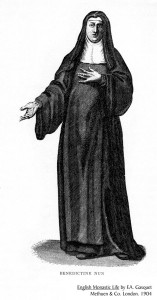By Elizabeth A. Lehfeldt (W&M Regular Contributor)
In the early fifteenth century male ecclesiastical visitors to the convent of Santa Clara in Barcelona cited the nuns for wearing an irregular and inappropriate habit. Rather than donning the traditional garb of Franciscan nuns, a gray or brown habit, the nuns wore a black habit more like that of the Benedictine Order. The visitors objected, but the nuns resisted and stuck to their sartorial guns. Stubborness prevailed on both sides of the debate and the contest over their habits dragged on for about a century and was ultimately appealed to Rome. Why were both sides so persistent? How did a question of clothing reach all the way to the papcy? Considering that the nuns were rarely, if ever, seen by others, why did it matter what they wore?
I have written previously here about the ways in which premodern clothing made statements about class and identity. It was not different for the nuns. Despite the fact that one modern historian has trivialized the decision of the Santa Clara nuns, claiming that the nuns simply wanted to exchange a drab habit for a more prestigious one*, it is clear that there was much at stake for these Franciscan women.
In fact, although Franciscan, the convent had a history of wearing the Benedictine habit. The nuns traced unbroken lineage to what they called the habit of San Damiano. This was a reference to the first religious community personally founded by Saint Clare in the early-thirteenth century. Because there was a ban on new religious orders when the community was formed in 1219, Cardinal Hugolino had placed the women under the Benedictine Rule. For the nuns of Santa Clara of Barcelona wearing the Benedictine habit let them claim an institutional identity built on a centuries-old connection between themselves and their sainted foundress. The nuns resisted the attempts to make them wear the Franciscan habit, and ultimately transferred the convent to the Benedictine Order. The local Franciscan hierarchy objected vigorously and appealed the decision to Rome. But the papacy upheld the nuns’ choice.
Another dispute over habits rooted in questions of identity erupted at the convent of Le Vergini in Venice. Here, in the early sixteenth century, the Augustinian nuns fought over a different choice of colors. A group of nuns was sent to reform the community and they wore grey habits. The original members wore white. After some discussion the two groups reached an agreement that they would all wear white. Trouble ensued, however, when the lay sisters (women who didn’t take solemn vows and frequently performed more menial tasks around the convent) adopted this color for their habits. Their decision violated a long-standing tradition of distinguishing between the habits worn by choir nuns and habits worn by lay sisters—a kind of hierarchy within the convent. The solemnly professed nuns wanted to be certain that the color of their habits signified their status as distinct.[1]
Habits, then, though hardly ever seen by outsiders, embodied important issues. Despite the monastic lifestyle’s insistence upon washing away attachments to material culture, habits mattered immensely to the women who wore them. Woven through their colors were questions of identity, tradition, and hierarchy.
* Interestingly, because of the dyes needed to prepare it, black was an expensive color to produce in the late Middle Ages, which may have made black habits a more prestigious item.
Elizabeth A. Lehfeldt is Chair and Professor of History at Cleveland State University. She writes on the history of gender in premodern Europe.
[1] For more on this story, see Kate Lowe’s, Nuns’ Chronicles and Convent Culture in Renaissance and Counter-Reformation Italy (New York, 2003).

